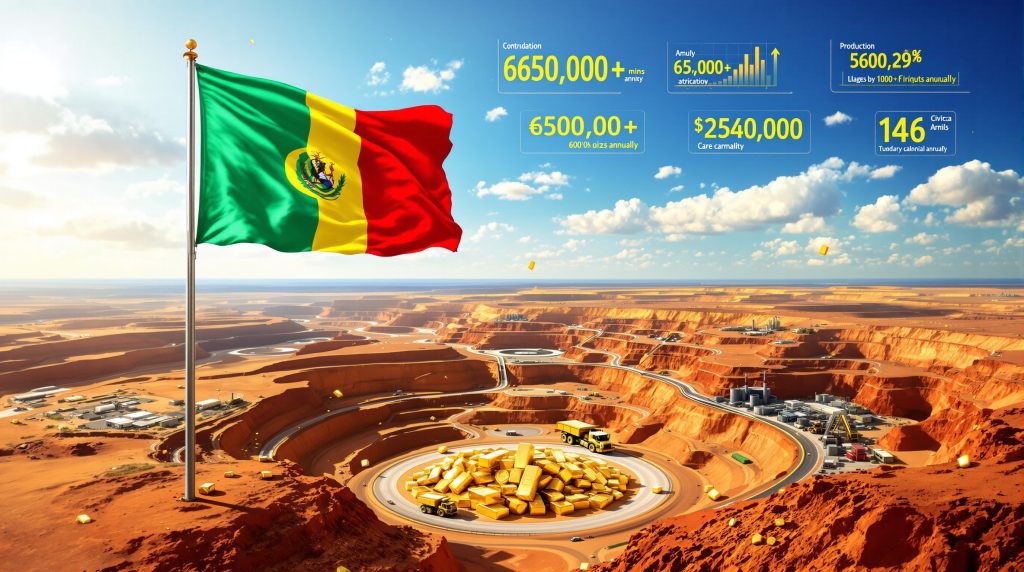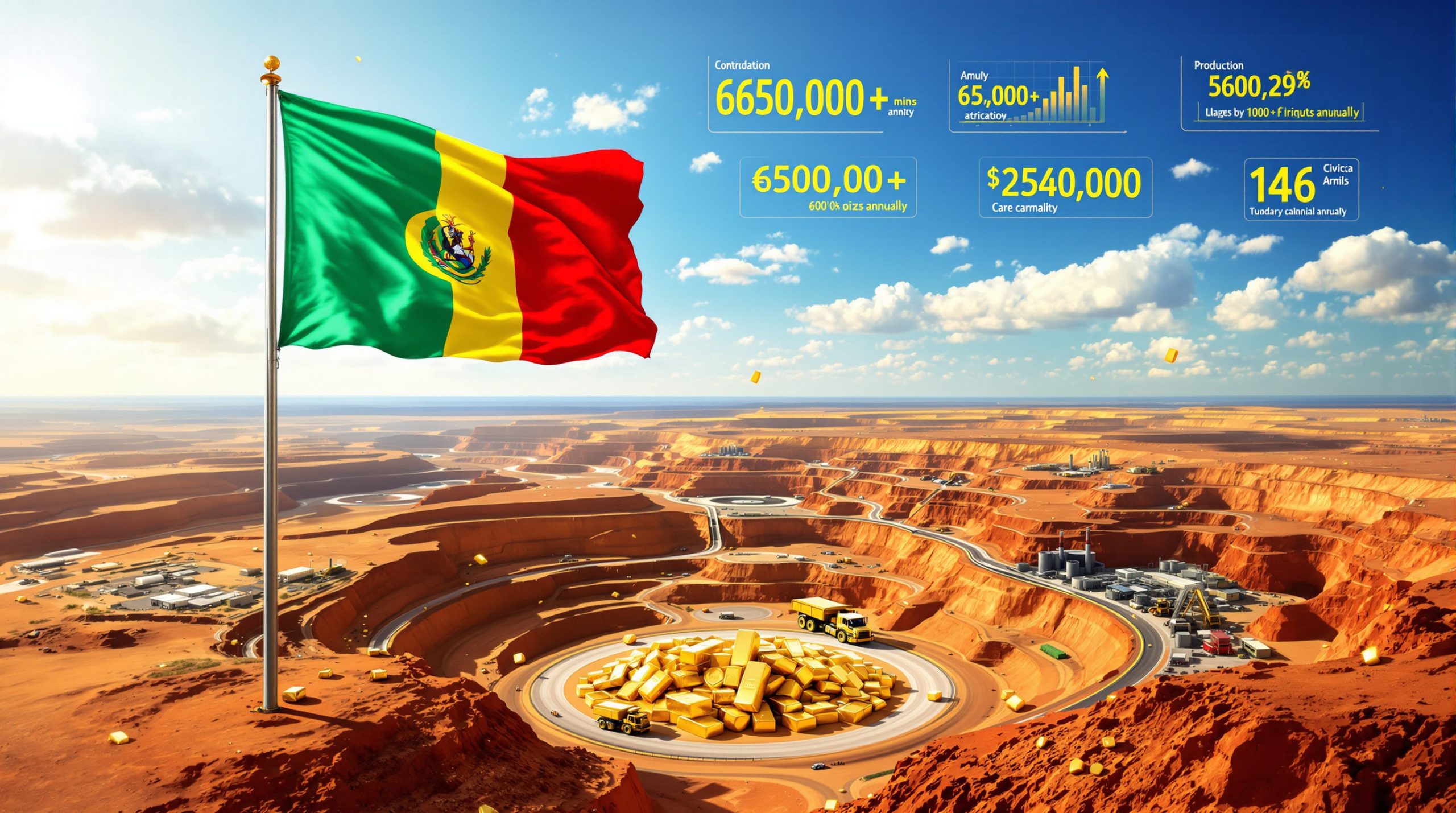Understanding West Africa's Mining Code Revolution
Resource nationalism across West African nations has fundamentally transformed the relationship between international mining companies and host governments. The movement toward greater state control over extractive industries reflects decades of accumulated grievances over colonial-era mining agreements that historically favoured foreign investors at the expense of local economic development.
Mali's implementation of a comprehensive new mining code in 2023 exemplifies this regional shift. The legislation increased royalty rates from 3% to 7%, representing a dramatic 133% increase in government revenue per ounce extracted. These changes extend beyond simple tax adjustments to encompass fundamental alterations in ownership structures, operational control, and revenue distribution mechanisms.
The economic drivers behind these policy shifts stem from volatile commodity cycles that exposed the inadequacy of fixed-rate agreements. When gold prices surged above $2,000 per ounce, governments across the Sahel recognised that existing contracts prevented them from capturing fair value from their natural resources. Military governments in Mali, Burkina Faso, and Niger have particularly emphasised resource sovereignty as a cornerstone of economic independence from former colonial powers.
Foreign direct investment flows into West African extractive industries have become increasingly contingent on acceptance of enhanced government participation. Furthermore, understanding global tax and royalty trends becomes essential for companies navigating these new regulatory landscapes. International mining companies now face a binary choice: adapt to new partnership models that prioritise local value capture or exit these resource-rich jurisdictions entirely.
What Makes the Loulo-Gounkoto Complex a Strategic Asset?
The Loulo-Gounkoto mining complex represents one of West Africa's most significant gold production facilities, generating over 650,000 ounces annually through integrated open-pit and underground operations. This production capacity places it among the continent's top-tier mining assets, contributing substantially to both Barrick's global portfolio and Mali's national economy.
Employment economics at the complex demonstrate remarkable local integration, with 97% of the workforce drawn from Malian nationals. This employment structure creates profound economic multiplier effects throughout the surrounding region, supporting approximately 8,000 direct jobs and countless indirect economic opportunities across supply chains and service sectors.
Technical Operations Overview
The complex utilises sophisticated dual-extraction methodologies combining surface mining techniques with underground shaft systems. This hybrid approach maximises ore recovery while adapting to varying geological conditions across the deposit. Processing capacity optimisation has enabled consistent production despite fluctuating ore grades and challenging operational environments.
Infrastructure dependencies extend far beyond the mine site itself, encompassing transportation networks, power generation systems, and water management facilities that serve broader regional development needs. The complex's logistics networks connect interior mining operations to international export channels, creating strategic transportation corridors that benefit multiple economic sectors.
Revenue contribution to Mali's national budget exceeds $50 million annually through direct taxation, royalty payments, and employment-related economic activity. During the recent operational suspension, this revenue stream disappeared entirely, creating fiscal pressures that motivated both parties toward dispute resolution.
The seizure of 3 metric tons of gold during the dispute highlighted the complex's substantial daily production capacity and the government's willingness to exercise direct control over mineral assets. This action demonstrated how quickly operational disputes can escalate beyond contractual disagreements to involve physical asset control.
Why Do Mining Disputes Escalate to Operational Shutdowns?
Mining disputes in resource nationalism contexts follow predictable escalation patterns driven by asymmetric bargaining power and incompatible legal frameworks. Host governments possess ultimate authority over licensing, taxation, and operational permits, while international companies control technical expertise, capital, and international market access.
The Barrick Mali gold mine dispute exemplifies how these tensions manifest in practice. Beginning in 2023 with implementation of Mali's new mining code, the disagreement initially focused on tax obligations and government equity participation requirements. When negotiations stalled, the government deployed increasingly aggressive pressure tactics.
Government Leverage Mechanisms
Licence renewal authority represents the most potent government negotiation tool. With Barrick's operating licence expiring in February 2026, Mali could effectively terminate operations by refusing renewal. This timeline pressure created existential urgency for Barrick while providing Mali with non-negotiable leverage.
Asset seizure and export restrictions demonstrate direct government control over mining output. The confiscation of 3 metric tons of gold sent an unambiguous message about state willingness to interrupt revenue streams. Export restrictions prevent companies from monetising production, creating immediate cash flow crises that accelerate negotiation timelines.
Executive detention as a pressure tactic represents the most controversial aspect of mining dispute escalation. The arrest of four Barrick employees elevated the conflict beyond commercial disagreement to involve personal safety concerns. This tactic forces corporate leadership to prioritise employee welfare over financial considerations, fundamentally altering negotiation dynamics.
Corporate Risk Management Strategies
International arbitration through ICSID provides companies with theoretical legal recourse against host government actions. However, enforcement mechanisms remain limited, particularly in jurisdictions with weak rule of law or political motivations for defying international commercial tribunals.
Operational suspension versus continued negotiation reflects complex strategic calculations. Barrick's decision to suspend operations in January 2024 demonstrated commitment to protecting employee safety while maintaining pressure on the government to honour existing agreements. However, extended shutdowns create their own risks through asset deterioration and community relationship damage.
In addition, understanding similar government revenue interventions helps companies prepare for various forms of state interference. Stakeholder communication during disputes requires delicate balance between transparency and confidentiality. Companies must inform investors about material risks while avoiding statements that could inflame tensions or prejudice ongoing negotiations.
Economic Impact Analysis: When Major Mines Go Offline
Operational shutdowns at major mining facilities create cascading economic disruptions that extend far beyond immediate production losses. The Barrick Mali dispute generated a comprehensive case study in how resource conflicts affect multiple stakeholder groups simultaneously.
| Impact Category | Barrick Gold | Mali Government | Regional Economy |
|---|---|---|---|
| Lost Production | 487,500+ oz reduction | $50M+ tax revenue loss | 8,000+ jobs affected |
| Settlement Costs | $438M payment | Arbitration expenses | Supply chain disruption |
| Reputational Risk | Investor confidence decline | FDI deterrence | Regional uncertainty |
Production losses during the nine-month suspension period eliminated approximately 487,500 ounces of gold output, representing significant revenue reduction for Barrick and corresponding tax revenue losses for Mali. The government's appointment of a provisional administrator in June 2024 partially restored operations, though full capacity did not resume until October 2024.
Financial consequences for Barrick included not only lost production revenue but also ongoing operational costs for facility maintenance, security, and employee compensation during the shutdown period. The eventual $438 million settlement payment represented substantial additional cost beyond operational losses.
Mali's government faced competing pressures between short-term revenue loss from suspended operations and longer-term benefits from establishing precedent for resource sovereignty. The $50 million annual tax revenue elimination created fiscal challenges for a government already facing economic constraints.
Regional economic impacts affected thousands of workers and hundreds of supplier companies dependent on mining operations. Supply chain disruptions rippled through transportation, catering, equipment maintenance, and professional services sectors, creating unemployment and business failures throughout the region.
How Do New Mining Codes Change Investment Calculations?
Mali's new mining code fundamentally altered the economic equation for international mining investments through comprehensive tax structure modifications and ownership requirements. The royalty rate increase from 3% to 7% represents a 133% increase in government revenue capture per ounce produced, significantly reducing project profitability for operators.
Tax Structure Modifications
Corporate tax adjustments incorporated progressive taxation elements that increase government revenue capture during high commodity price periods. Windfall provisions enable automatic tax rate increases when gold prices exceed predetermined thresholds, ensuring state participation in commodity super-cycles.
Export duty implementations create additional revenue streams for governments while reducing company profit margins. These duties operate independently of production taxes, creating multiple layers of government revenue extraction from mining operations.
Ownership Requirements
Government equity participation mandates require companies to cede ownership stakes to host governments, diluting investor returns while providing states with direct ownership benefits. These requirements typically apply retroactively to existing operations, not just new projects.
Local content procurement obligations force companies to source specified percentages of goods and services from domestic suppliers, even when international alternatives offer better quality or pricing. Furthermore, South Africa mineral beneficiation provides examples of how governments implement value-addition requirements. Technology transfer expectations require companies to share operational expertise and training with local partners.
Investment decision frameworks now incorporate significantly higher risk premiums for West African projects. Companies must model scenarios including potential government renegotiation, operational interruption, and asset seizure when calculating project economics.
What Does Successful Dispute Resolution Look Like?
The Barrick Mali settlement reached in principle during August 2025 provides a comprehensive framework for understanding how resource sovereignty disputes can achieve mutually acceptable resolution. The agreement addressed multiple dimensions of conflict through carefully balanced concessions from both parties.
The Mali-Barrick agreement demonstrates how resource disputes can be resolved through financial compensation, operational concessions, and mutual face-saving mechanisms that preserve long-term partnerships while acknowledging changed economic realities.
Negotiation Framework Elements
Licence extension to 2036 with renewal options provided Barrick with ten years of operational certainty beyond the original February 2026 expiration date. This extended timeline enables long-term investment planning while giving Mali ongoing leverage through future renewal negotiations.
Employee release and asset return protocols addressed the most contentious aspects of the dispute. The release of four detained Barrick employees and return of 3 metric tons of seized gold demonstrated government willingness to restore normal operational relationships in exchange for broader agreement compliance.
Arbitration withdrawal and future dispute mechanisms required Barrick to abandon ICSID proceedings against Mali while establishing frameworks for addressing future disagreements through bilateral negotiation rather than international litigation.
The $438 million settlement payment acknowledged Mali's resource sovereignty demands while providing a quantifiable resolution cost for Barrick. This payment effectively bought operational peace and licence security while validating the government's negotiating strategy.
Key Settlement Components
Financial compensation addressed government revenue demands without requiring ongoing operational changes that could create future dispute triggers. The one-time payment structure provided Mali with immediate fiscal benefits while avoiding complex ongoing revenue-sharing arrangements.
Operational concessions included acceptance of new mining code provisions that increase government revenue capture from future operations. Barrick's agreement to operate under enhanced tax rates demonstrated company willingness to adapt to changed regulatory environments.
Mutual face-saving elements allowed both parties to claim victory: Mali achieved recognition of resource sovereignty principles and substantial financial compensation, while Barrick secured long-term operational rights and restored normal business relationships.
Regional Implications for West African Mining Investment
The Barrick Mali resolution establishes important precedent for mining disputes across West Africa, where approximately 60% of major operations have experienced government disagreements since 2020. This pattern reflects broader regional trends toward resource nationalism and enhanced state participation in extractive industries.
Precedent Setting for Other Operations
Similar disputes in Burkina Faso and Niger demonstrate common patterns of government pressure tactics and company response strategies. The Barrick and Mali have reached an agreement to resolve their dispute, providing a reference point for other negotiations. The Mali settlement's financial magnitude and structural elements provide reference points for ongoing negotiations in other jurisdictions.
Multinational mining company strategic adjustments include enhanced political risk assessment methodologies, increased community engagement investments, and development of rapid dispute resolution protocols. Companies are incorporating higher contingency costs into project budgets to account for potential government renegotiation.
Risk premium calculations for new West African projects now incorporate specific modelling for resource nationalism scenarios. Investment hurdle rates have increased to reflect higher political risks, potentially reducing overall investment flows into the region.
Geopolitical Context
Military government priorities and legitimacy concerns drive resource sovereignty policies as mechanisms for demonstrating independence from former colonial powers. Successful extraction of concessions from international companies provides domestic political benefits for governments seeking to establish credibility.
French colonial legacy and economic independence movements create additional complexity for companies from former colonial powers. Alternative investment sources, particularly from China and other emerging economies, provide host governments with enhanced negotiating leverage against traditional Western mining companies.
Chinese investment alternative considerations include different risk tolerance levels and potentially more flexible partnership structures that may better accommodate resource sovereignty demands. This competition for mining assets creates additional pressure on Western companies to accept less favourable terms.
Investment Strategy Adaptations in High-Risk Jurisdictions
International mining companies operating in West Africa have fundamentally revised their investment strategies in response to resource nationalism trends and the lessons learned from high-profile disputes like Barrick's experience in Mali.
Due Diligence Evolution
Political risk assessment methodologies now incorporate detailed modelling of government transition scenarios, resource nationalism probability calculations, and dispute escalation timelines. Companies evaluate historical patterns of government behaviour toward foreign investors and assess current political pressures that might motivate policy changes.
Community engagement and local partnership strategies have evolved beyond traditional corporate social responsibility programmes to encompass meaningful economic partnership development. Companies increasingly establish local business partnerships, educational institutions, and economic development programmes that create stakeholder alignment with continued mining operations.
Contingency planning for operational disruptions includes scenario planning for employee detention, asset seizure, and operational suspension. Companies maintain crisis management protocols, emergency evacuation procedures, and rapid response legal strategies for deployment during dispute escalation.
Risk Management Framework
| Risk Category | Assessment Criteria | Mitigation Strategy |
|—|—|—|—|
| Government Change | Political stability indicators | Diversified stakeholder engagement |
| Resource Nationalism | Policy trend analysis | Enhanced local partnership |
| Operational Interruption | Dispute escalation patterns | Crisis management protocols |
| Asset Seizure | Legal framework strength | Political risk insurance |
Political risk insurance utilisation has increased dramatically across West African operations. Companies purchase comprehensive coverage for asset expropriation, operational interruption, and currency inconvertibility to protect against government actions that could eliminate investment value.
Multilateral development bank participation provides additional political risk mitigation through international institutional involvement in project financing. When development banks maintain equity stakes or debt positions in mining projects, host governments face international diplomatic pressure to honour commercial agreements.
Future Outlook: Balancing Sovereignty and Investment
The evolution of West African mining relationships reflects broader global trends toward enhanced state participation in natural resource extraction. Successful future partnerships will require fundamental reconceptualisation of the traditional mining investment model to accommodate legitimate government sovereignty demands while maintaining commercial viability.
Sustainable Partnership Models
Revenue-sharing mechanisms that adapt to commodity cycles provide governments with enhanced participation in mineral wealth while protecting company returns during market downturns. Progressive taxation structures automatically adjust government revenue capture based on commodity prices, eliminating the need for periodic contract renegotiation.
Local value addition requirements and processing mandates encourage domestic industrial development while creating additional revenue streams for mining companies. Rather than exporting raw materials, companies can develop local processing capabilities that generate employment and technology transfer benefits.
Environmental and social governance integration creates shared value propositions that align company operations with national development priorities. Mining companies increasingly serve as infrastructure developers, educational institutions, and healthcare providers in remote regions where government services are limited.
Emerging Partnership Structures
| Partnership Element | Government Benefit | Company Benefit |
|—|—|—|—|
| Progressive Taxation | Higher revenue during price booms | Reduced costs during downturns |
| Local Processing | Industrial development | Value-added revenue streams |
| Infrastructure Investment | Public service delivery | Operating cost reduction |
| Technology Transfer | Capacity building | Skilled workforce development |
Risk Mitigation Innovation
Regional diplomatic engagement protocols involve multinational coordination between mining companies and diplomatic missions to address disputes before they escalate to operational interruption. Early warning systems identify political risk factors and trigger preventive engagement strategies.
Multilateral institutional involvement through development finance institutions provides neutral mediation capabilities while creating international stakeholder pressure for dispute resolution. These institutions can facilitate dialogue while providing technical assistance for sustainable partnership development.
Lessons for Global Mining Investment
The resolution of the Barrick Mali gold mine dispute illuminates fundamental shifts in the global mining industry's relationship with resource-rich developing nations. The successful negotiation demonstrates that resource sovereignty movements, while creating short-term operational challenges, can ultimately lead to more sustainable partnership models that better balance legitimate government interests with commercial investment requirements.
Key lessons include the critical importance of proactive stakeholder engagement, comprehensive political risk assessment, and adaptive contract structures that can accommodate evolving government priorities. Companies that view resource nationalism as an insurmountable obstacle may miss opportunities to develop innovative partnership models that create shared value for all stakeholders.
The $438 million settlement, while substantial, provided Barrick with ten years of operational certainty and restored access to a world-class mining asset. For Mali, the agreement validated resource sovereignty principles while securing long-term economic benefits through continued mining operations and enhanced revenue participation. Additionally, understanding gold prices and market dynamics remains crucial for evaluating such investments.
Future mining investments in West Africa and similar jurisdictions will likely require higher upfront community investment, enhanced government partnership structures, and greater flexibility in operational agreements. Companies that adapt successfully to these requirements will secure competitive advantages in accessing high-quality mineral resources, whilst those that resist change may find themselves excluded from resource-rich markets entirely.
The broader implications extend beyond West Africa to resource nationalism movements worldwide. As developing nations seek greater control over natural resource wealth, international mining companies must evolve beyond traditional extraction models toward genuine partnership approaches that create mutual prosperity and sustainable development outcomes. Furthermore, implementing effective gold market investment strategies becomes essential for navigating these evolving landscapes. Companies that recognise this shift early will be best positioned to benefit from the resolution of the Barrick Mali gold mine dispute and similar developments.
Ready to Capitalise on Major Mining Developments?
Discovery Alert's proprietary Discovery IQ model delivers real-time notifications on significant ASX mineral discoveries, instantly empowering subscribers to identify actionable opportunities ahead of the broader market. Understand why major mineral discoveries can lead to substantial market returns by exploring Discovery Alert's dedicated discoveries page, showcasing historic examples of exceptional outcomes, and begin your 30-day free trial today to position yourself ahead of the market.




